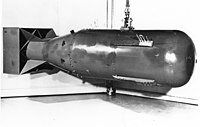
Photo from wikipedia
The recent advent of polarimetric phased array radars (PPARs) used for weather observations fosters the need to study the radar system effects on the estimates of radar products. The major… Click to show full abstract
The recent advent of polarimetric phased array radars (PPARs) used for weather observations fosters the need to study the radar system effects on the estimates of radar products. The major challenges are the steering angle-dependent biases as well as the cross-coupling effects. To mitigate the latter, a pulse-to-pulse phase coding of transmitted pulses has been proposed. Here, three implementations of the phase coding concept are analyzed and compared. Two implementations have been presented in previous peer-reviewed works, while the third has not. Aspects of these implementations are analyzed and discussed, while their effectiveness is quantified as a function of the maximum cross-polar power. The analysis is conducted using theoretical developments and simulations. The latter is conducted using the patterns of a real PPAR antenna measured in a near-field anechoic chamber. Real PPAR radar data are used to provide experimental verification of the cross-coupling mitigation efficacy. The results derived from theoretical developments, simulations, and the real data analysis exhibit excellent trendwise agreement providing a strong indication of the cross-coupling mitigation effectiveness.
Journal Title: IEEE Transactions on Geoscience and Remote Sensing
Year Published: 2022
Link to full text (if available)
Share on Social Media: Sign Up to like & get
recommendations!